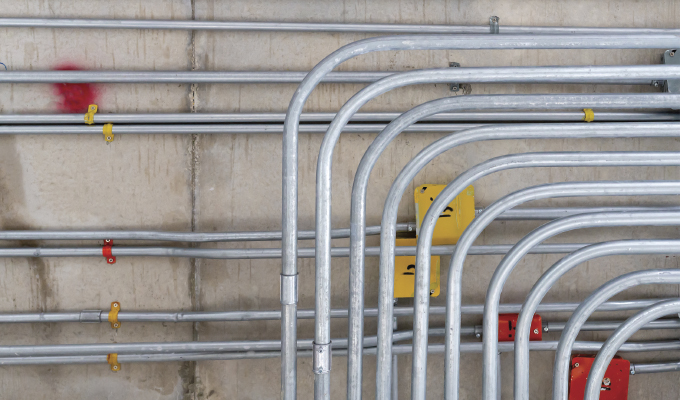Contractors face growing pressures to deliver on speed, budget and safety, all while navigating tighter labor pools, evolving building codes and increasing project complexity. Whether building data centers, hospitals or mixed-use commercial spaces, contractors today are expected to do more with less without compromising quality and safety.
One solution that continues to stand the test of time, while also evolving to meet new demands, is steel conduit. As both a physical barrier and a safety system, steel conduit remains one of the most effective ways to protect electrical wiring and infrastructure and the workers who install and maintain it. From fire prevention to digital training innovation, steel conduit plays a much larger role than many contractors may realize.
STEEL: THE FIRST LINE OF DEFENSE
Electrical fires and arc flash incidents remain some of the most dangerous threats on today’s construction sites and in completed commercial buildings. That’s where rigid steel conduit (RSC) offers distinct advantages. It acts not only as a protective casing for conductors, but also as a grounded pathway that contains faults, minimizing the risk of fire spread and electrical injury.
Unlike plastic or non-metallic raceways, RSC does not ignite, melt or off-gas under high heat or electrical stress. This makes it an ideal choice for mission-critical facilities, including healthcare campuses, educational institutions, and data centers, where failure is not an option and uptime is non-negotiable.
As performance-based codes become more prevalent across municipalities, selecting materials that demonstrate reliable safety under extreme conditions is no longer just best practice; it’s becoming a compliance necessity.
SAFETY BY DESIGN
For contractors, material selection plays a key role not just in meeting code, but in reducing long-term liability. In projects where mechanical protection and conductor containment are essential, rigid steel conduit continues to offer unmatched performance.
Facilities like hospitals, military installations, and telecommunications hubs all rely on steel conduit systems because they can withstand impact, corrosion, and fire without compromising the integrity of electrical systems. That translates into fewer callbacks, less maintenance, and safer operation throughout the life of the building.
Contractors also benefit during installation. Steel conduit provides a more consistent, secure routing method that resists bending or damage in the field. It helps maintain clearances and supports easy grounding, reducing the likelihood of installation-related faults that might delay inspections or jeopardize project timelines.
ADVANCED TECH IN MANUFACTURING
Steel is a time-tested material, but the way it’s manufactured, handled and installed has entered a new era, driven by artificial intelligence, digital modeling, and simulation training.
One of the most exciting developments in recent years has been the use of AI-enhanced safety tools in both training and real-time design. Manufacturers are now using artificial intelligence to monitor steel conduit production lines, automatically detecting anomalies in wall thickness, weld integrity, and heat levels to reduce the risk of failure later in the field. This not only ensures product consistency but minimizes risk before the conduit ever reaches the jobsite.
Meanwhile, digital twins, AR/VR simulations, and AI-driven modeling platforms are being used to prepare the next generation of tradespeople. Students and workers can now walk through virtual steel conduit installations, learning safe handling techniques and code-compliant routing practices in a zero-risk environment. These tools also enable project teams to evaluate routing options virtually, helping avoid overlaps with fire-rated walls or congested MEP zones before a single piece of conduit is cut.
AI and generative tools can analyze electrical conduit routing to avoid critical overlaps or fire-prone areas, optimize material placement to ensure resilience, and integrate safety into early design decisions. This proactive approach is not only more efficient, but safer by helping identify installation risks before boots hit the ground. For contractors, this means fewer mistakes, less rework, and improved team readiness on day one.
RAISING THE BAR THROUGH EDUCATION
In addition to evolving technologies, there’s growing recognition that jobsite safety starts with training and consistency. Digital credentialing programs help to ensure that anyone working with steel conduit is fully trained in safe installation techniques.
Online modules and AR/VR safety walkthroughs certify learners on proper handling and installation techniques of steel products. This approach not only modernizes continuing education but ensures consistency in safety standards across the industry.
Such programs are increasingly valuable as contractors onboard new employees or work with less experienced crews. Standardized digital training makes it easier to replicate best practices across jobsites, reduce variability, and meet rising owner expectations for safety documentation and compliance.
A SAFER PATH FORWARD
As construction continues to evolve, so too must the materials and methods that contractors rely on. Steel conduit, backed by new digital tools, AI-enabled quality control and immersive training platforms, offers a rare combination of proven performance and forward-thinking innovation.
Contractors navigating complex code environments, tighter timelines, and safety-first mandates can look to steel tubing not just as a component, but as a system-level solution, one that bridges the gap between jobsite safety, system integrity, and long-term building performance.
Material choices matter and when paired with smart technologies and informed design, they can dramatically reduce jobsite incidents and improve outcomes for everyone involved.
about the author
Dale L. Crawford is the Executive Director and Director of Conduit for the Steel Tube Institute. Dale is responsible for the organization’s activities to promote the growth and competitiveness of steel pipe and tubular products throughout North America. In addition to these responsibilities, he is in charge of activities, strategies, and programs of the Steel Tube Institute’s Conduit Section, which consists of North America’s leading steel conduit manufacturers. For more, visit www.steeltubeinstitute.org.


